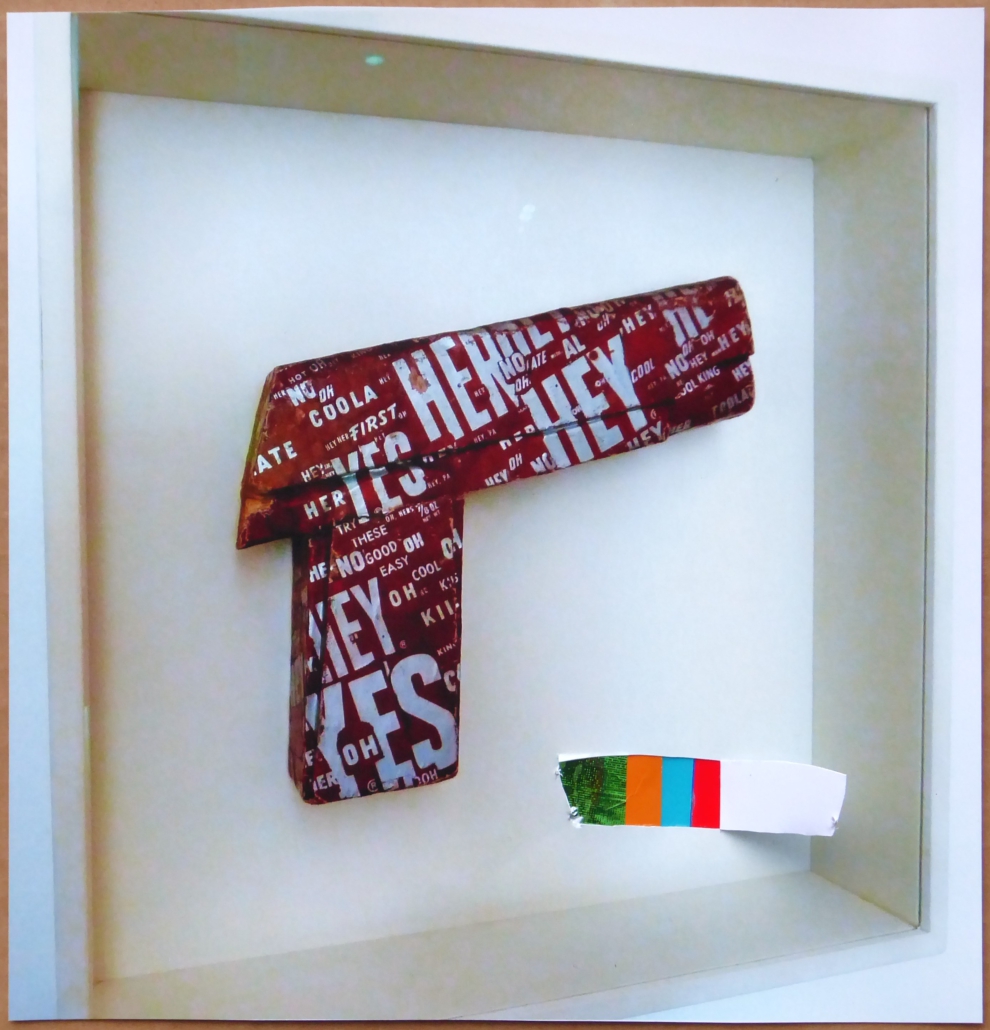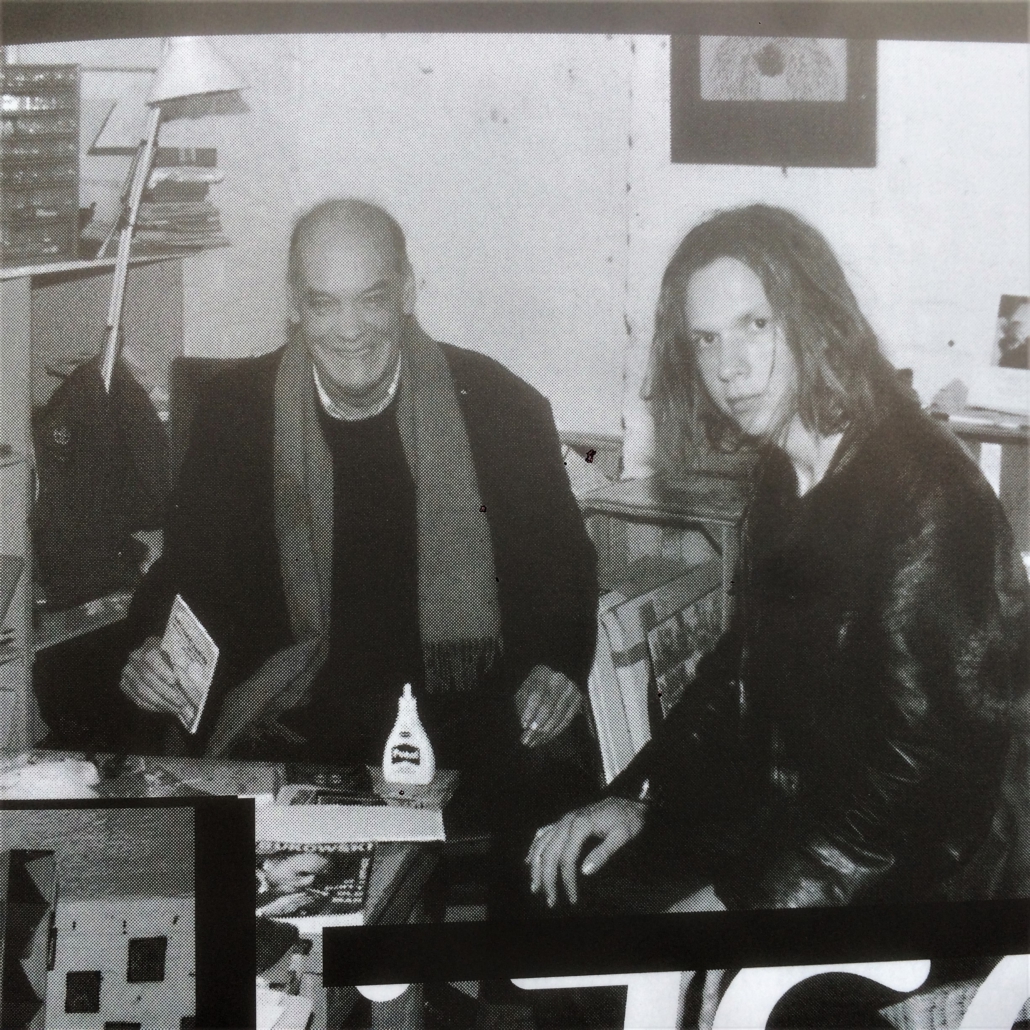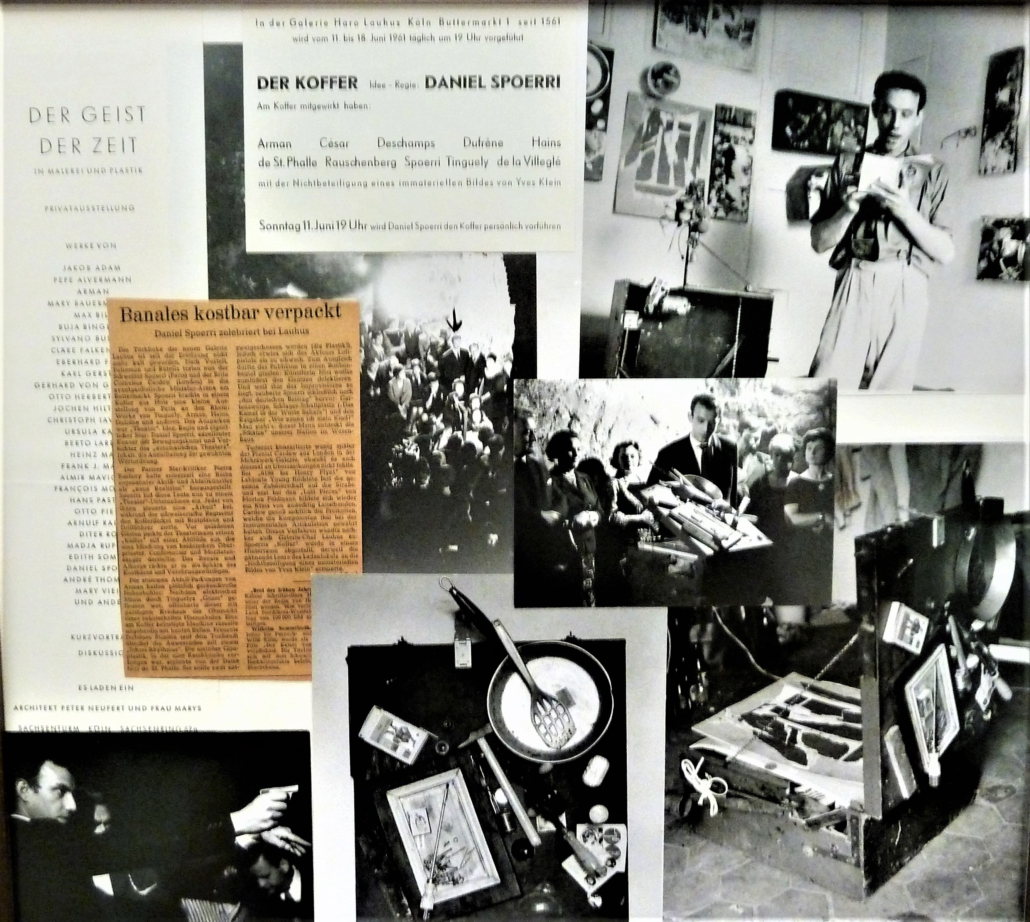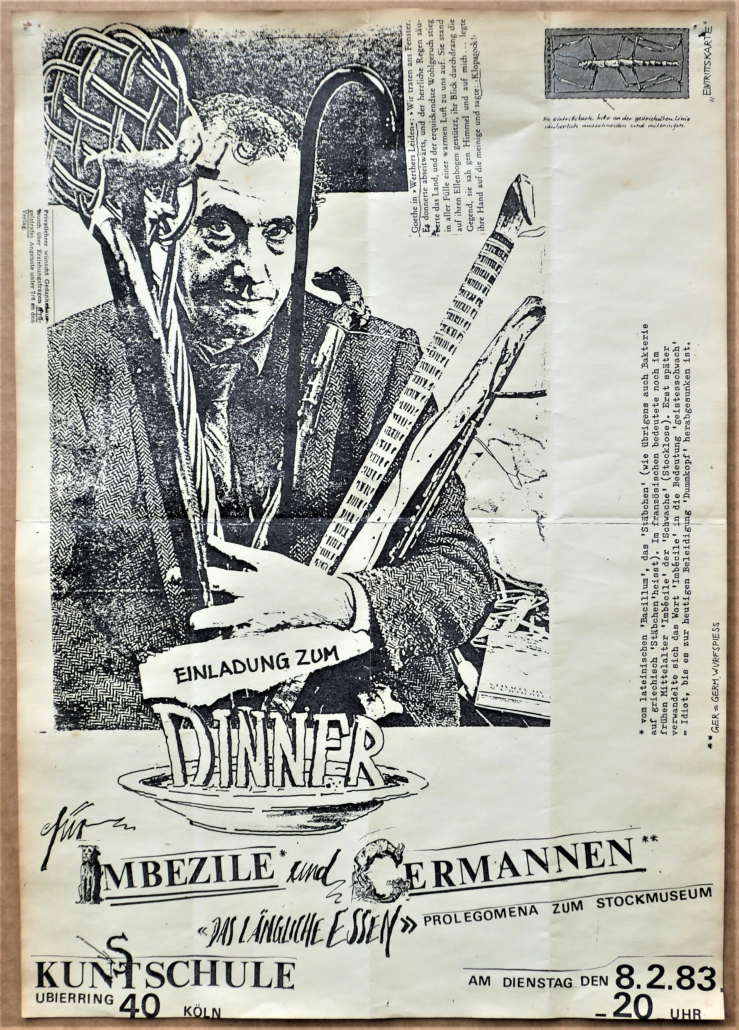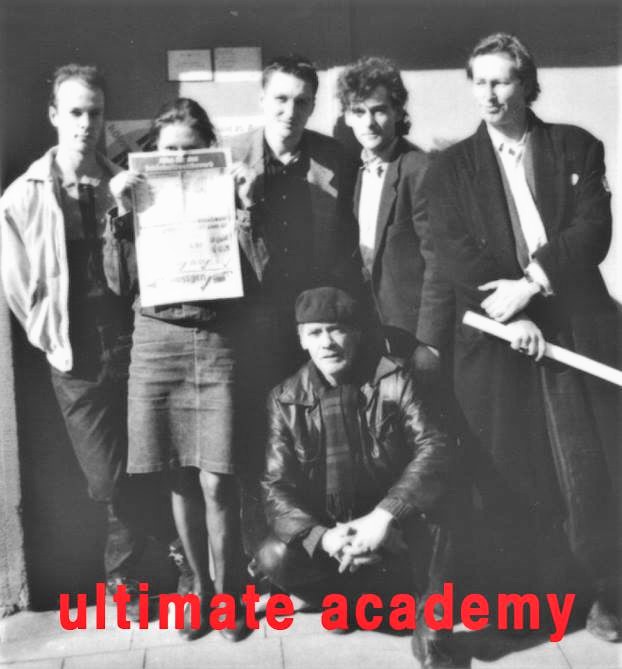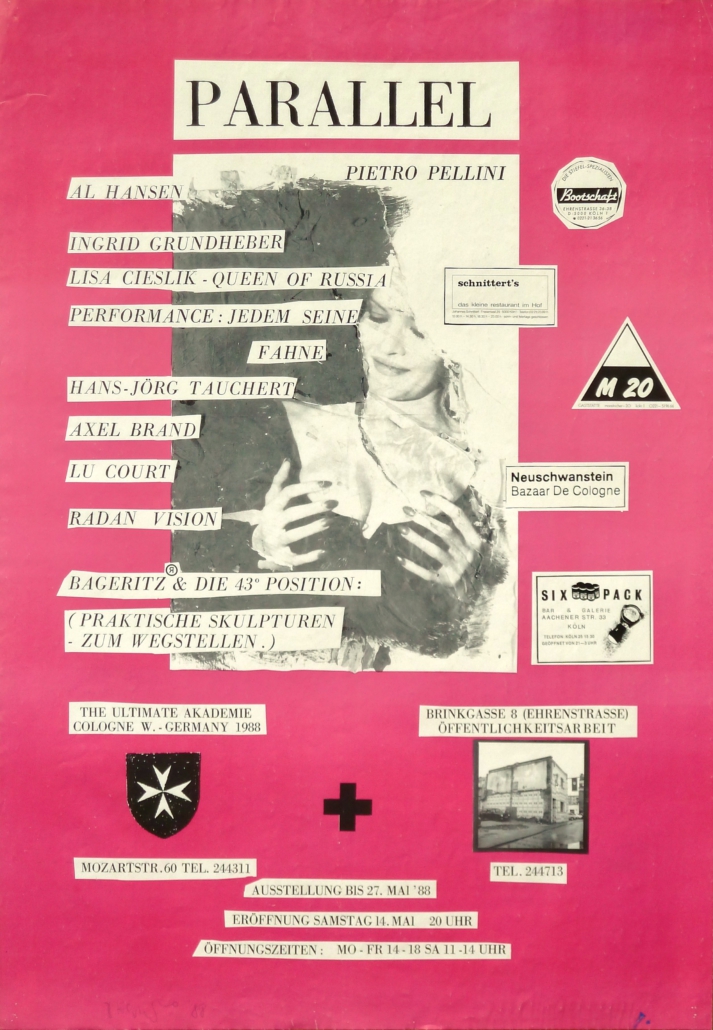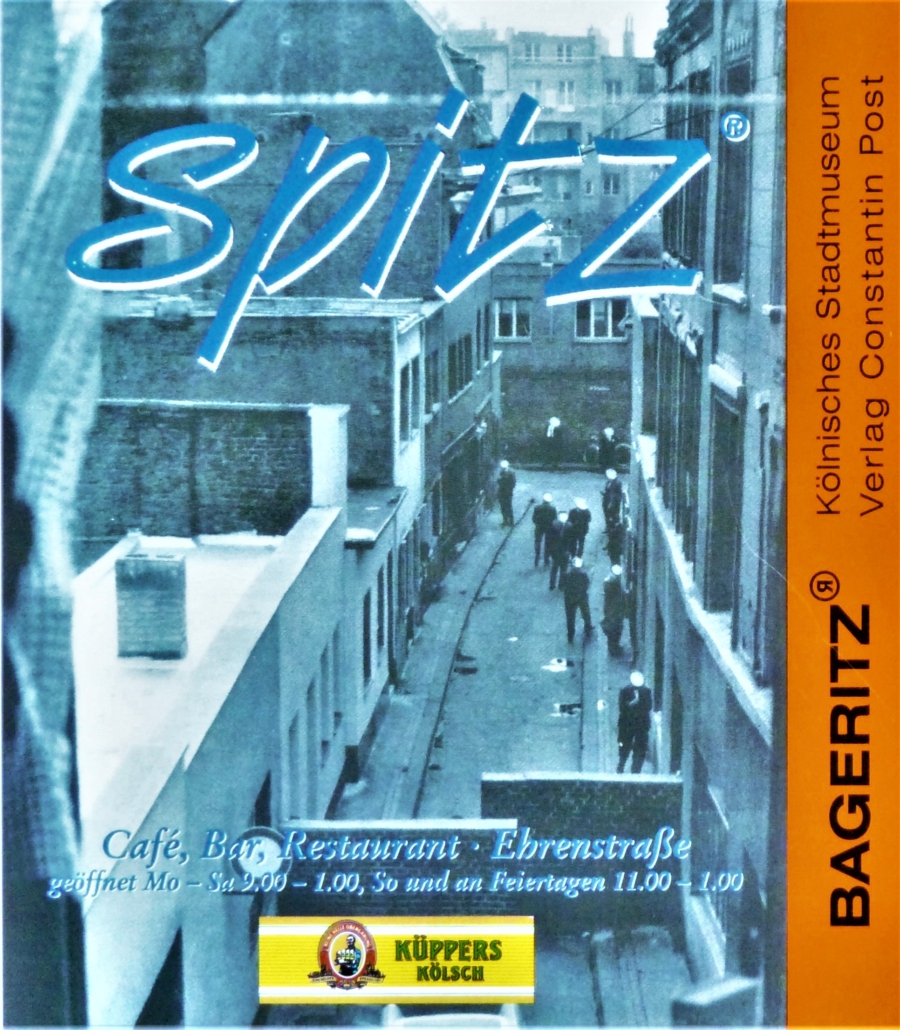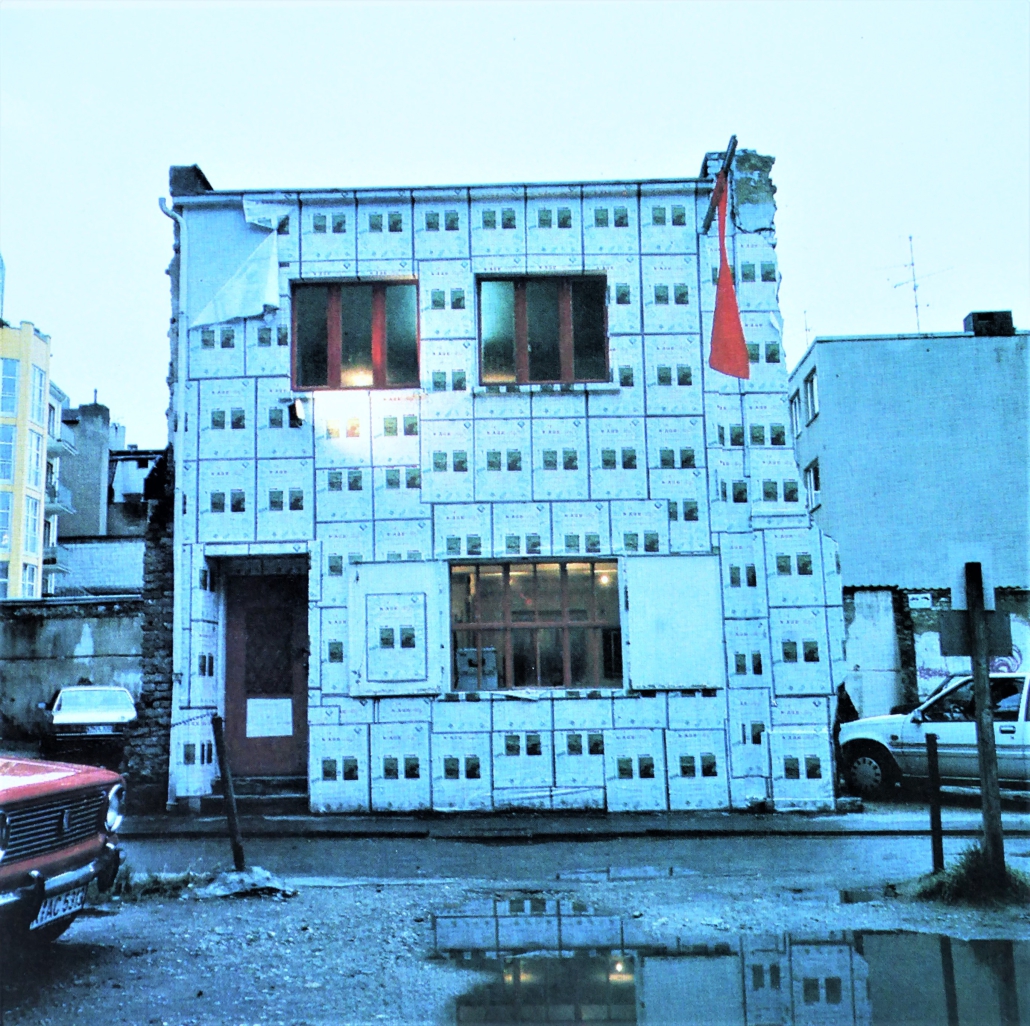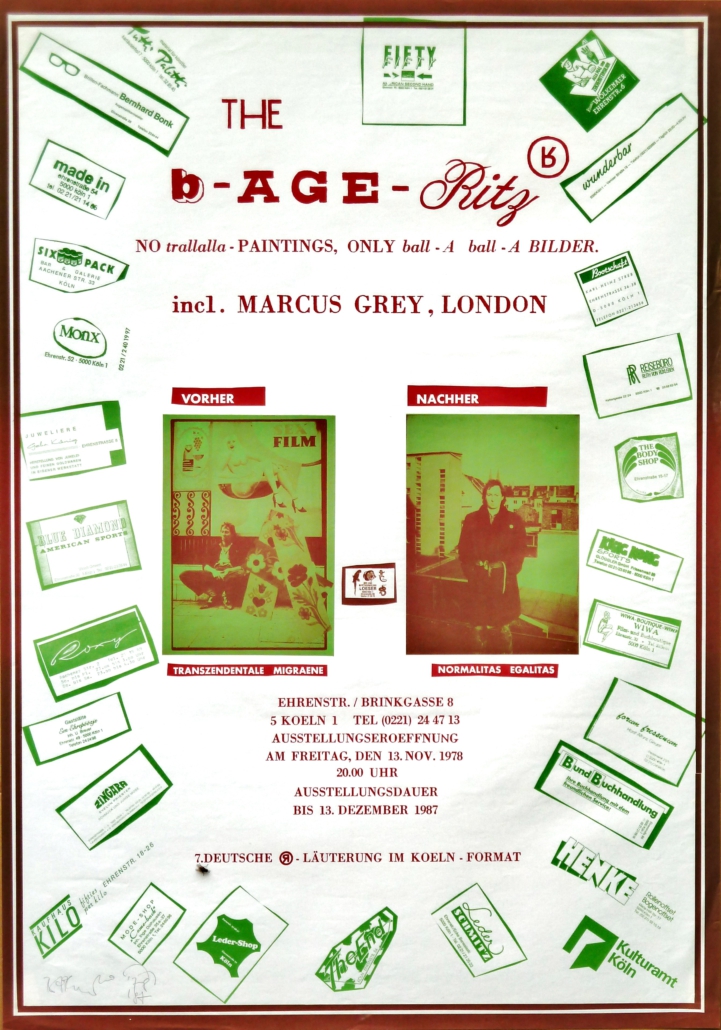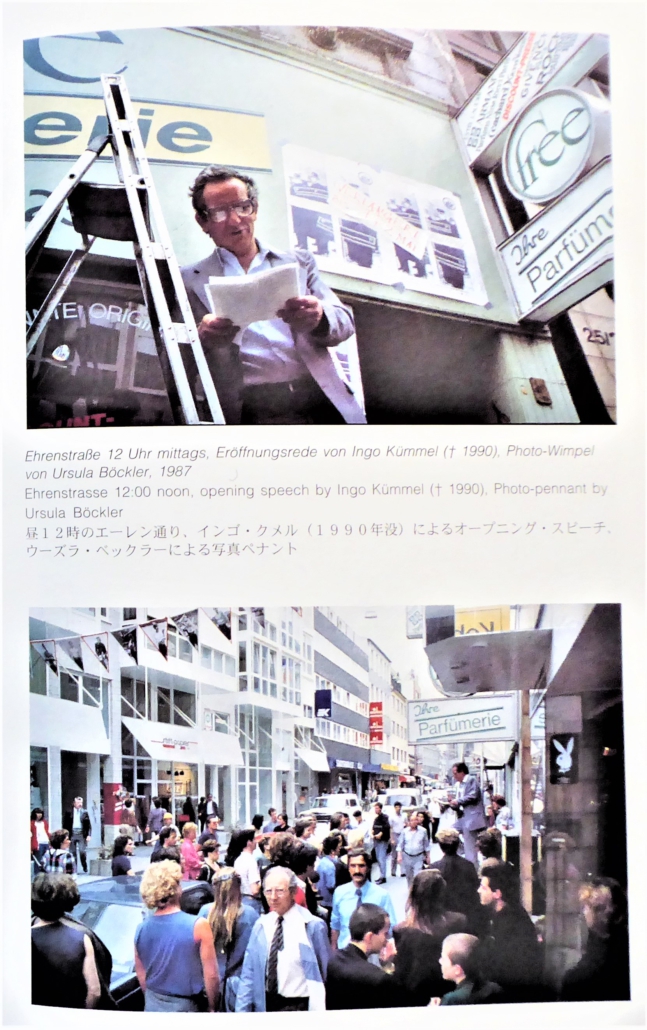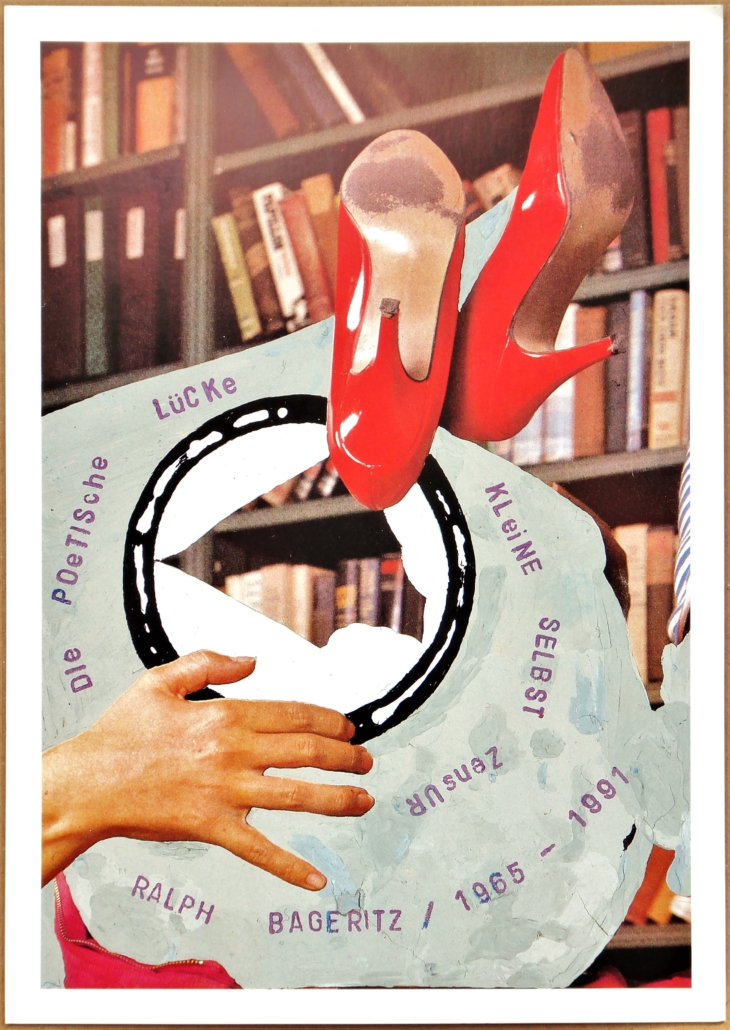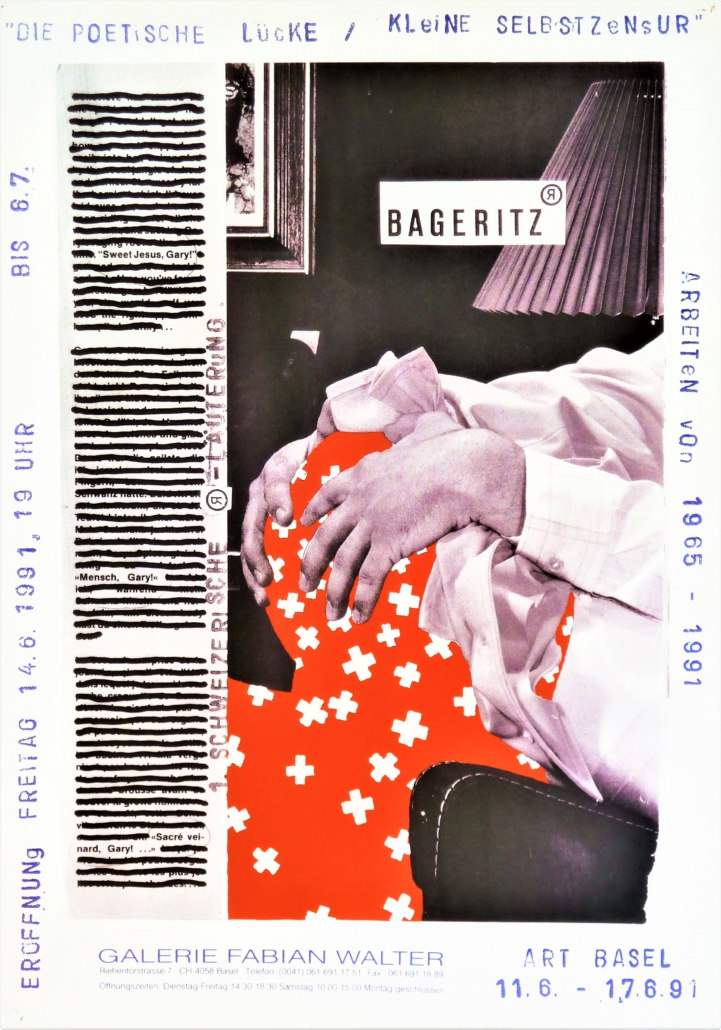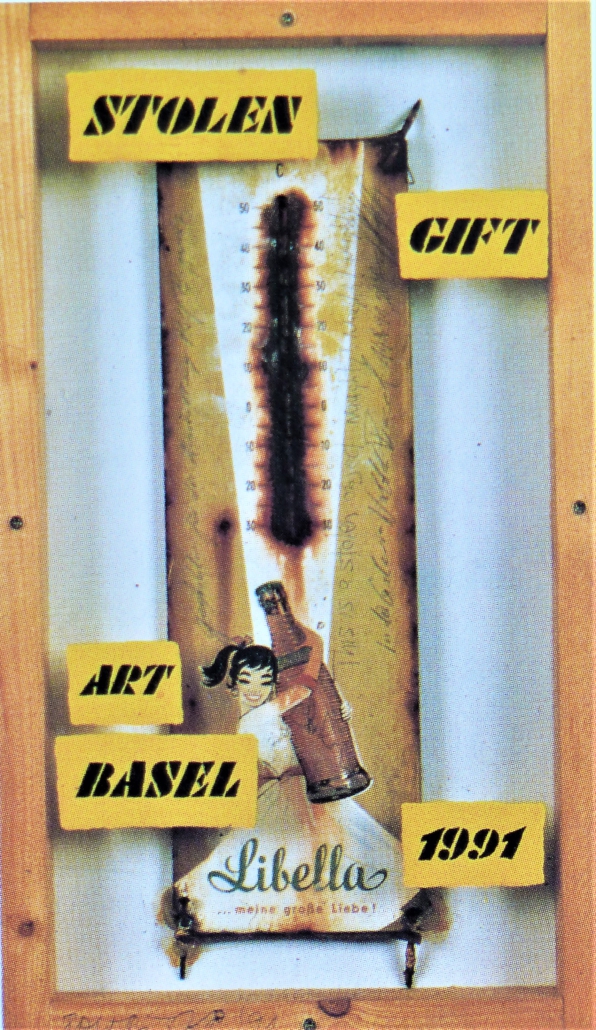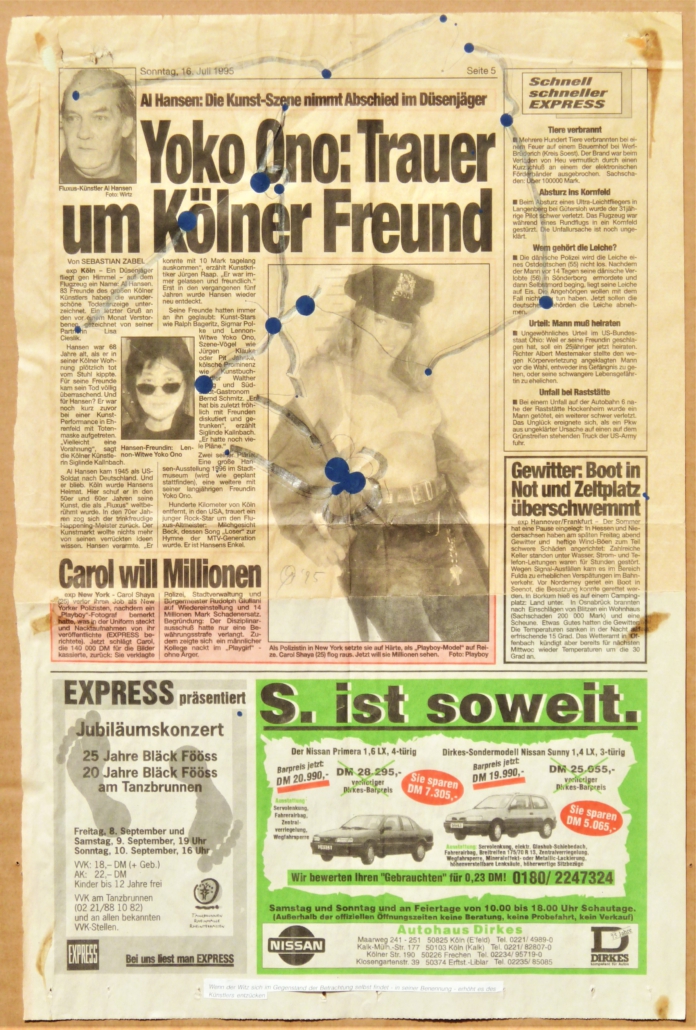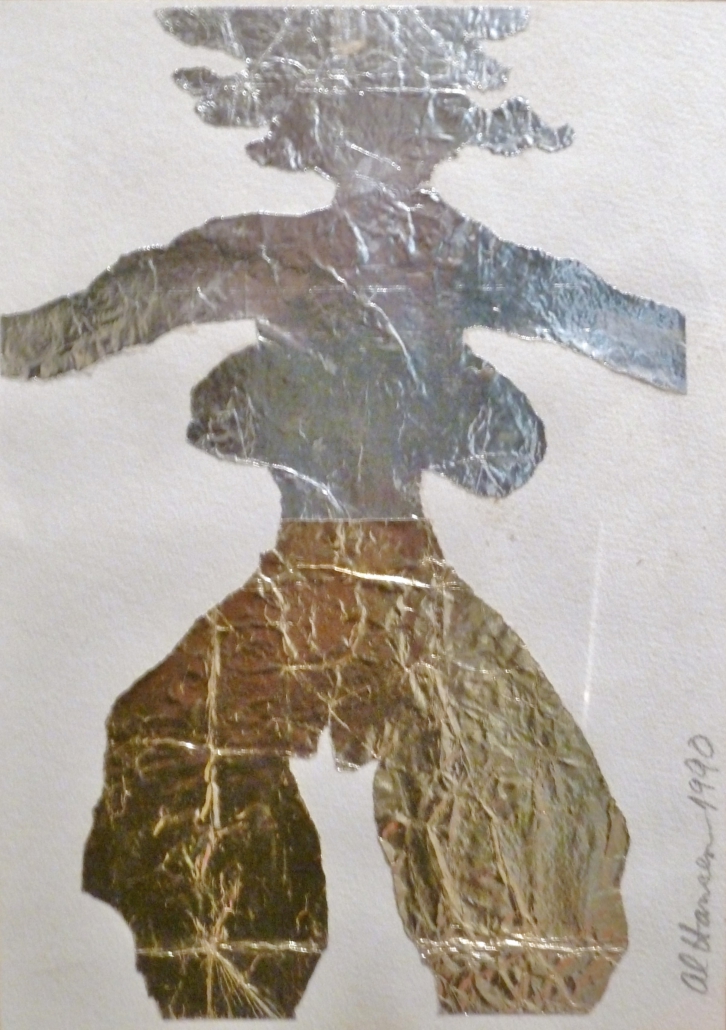Scroll down for english pleaze!
IN MEMORIAM AL HANSEN
(*5 Oktober 1927 – †22 Juni 1995)
DIE KUNSTSTADT KÖLN UM 1980 & DIE FRÜHE ZEIT DANACH
Eine ziemlich persönliche Erinnerung an den Fluxus- & Happening-Künstler AL (Alfred Earl) HANSEN –
von
RALPH BAGERITZ
HEY AL, WHAT´S GOING ON? –
Mal so oder so lautete unser Begrüßungsritual, wenn man sich traf, meist zufällig, zur richtigen Zeit am richtigen Ort – im Nachhinein betrachtet – auf den „Hauptweg- und Nebenwege(n)“¹
der damals boomenden rheinischen Kunstmetropole Köln, gleichbedeutend mit der Kunstszene New Yorks (Anfang bis Ende der 80er Jahre), in den speziellen Lokalitäten des Kunstbetriebs – und darüber hinaus. Al(ien) Hansen war aus meiner Sicht urplötzlich da, 1983, in der traditionsreichen heiligen Stadt, die ja bereits in den 60er/70er Jahren kunst-/markttechnische Bedeutung erlangt hatte:
1.Kölner Kunstmarkt im Gürzenich ´67 / Ingo Kümmels „Neumarkt der Künste“ ´68 / Gründung der internationalen Kunstmesse Art Cologne ´74.
Meine erste Begegnung mit dem SPIRIT OF AL HANSEN fand allerdings indirekt, 1982, im mittlerweile berühmten Seminar von Daniel Spoerri statt, des Objekt- und Fallenbildkünstlers selbstironisch betitelter „Kunstgeschichte aus dem Nähkästchen“, in direkter Verwertung eines kritischen O-Tons von Marlis Grüterich, Kunsthistorikerin an den Kölner Werkschulen resp. der Kunsthochschule am Ubierring.
Daniel Spoerri, Mitbegründer der Künstlergruppierung „Nouveau Réalisme“², Multi-Media-Skulpteur der ersten Stunde, vor allem aber versierter kunst- und künstlerkennender Zeitzeuge und somit prädestiniert fürs authentische Storytelling, fachresümierte ans studentische Publikum. So eben auch, unter vielen anderen wegweisend legendären Kunstereignissen, über die des New Yorker Künstlers Al Hansen, der 1946 als amerikanischer Besatzungssoldat während seiner Stationierung in Frankfurt in einer für mich genialen After-World-War-II-Aktion das wohl erste „Happening“ durchführte, indem er mitten in der Nacht ein Klavier aus einem ausgebombten fünfstöckigen Haus fallen ließ…
weiterlesen... / scroll down for english pleaze!
…Zurück in New York und nach diversen Wiederholungsaufführungen, benannt nun nach seiner damaligen Freundin, der Künstlerin Yoko Ono, „Yoko-Ono-Piano-Drop“, gilt diese Aktion als konzeptioneller Vorläufer sogenannter „Instrument-Zerstörungen“, so wie bei Nam June Paik und später u. a., bei Jimi Hendrix. Der frühe Bezug zur amerikanischen Fluxus-Bewegung, den Kontakten zu Künstlern wie John Cage, George Brecht, Dick Higgins, Allan Kaprow, Andy Warhols Factory sowie nachfolgende Mixed-Media-Environments lassen ihn zu den Pionieren der „Performance Art“ und des „Happenings“ zählen.
Zu Beginn der 60er Jahre entstehen seine ersten HERSHEY´S-Bildobjekte, zumeist Venus-Motive in Nachempfindung der prähistorischen „Venus von Willendorf“, collagiert aus dem Verpackungsmaterial des US-Schokoladenriegel-Klassikers.
1984 dann Hansens fulminanter Auftritt in Ingo Kümmels Graffiti-Kunsttempel „Stollwerck“, einer ehemaligen Schokoladenfabrik! – Kulminationsort für junge Kunst in der Kölner Südstadt. In eigener Reminiszenz und Empfehlung an die rheinische Szene warf er fünf Klaviere aus dem vierten Stock des Fabrikgebäudes – eine radikale ästhetische Crash-Sound-Symphonie zerberstenden Hochkultur-Materials im Zusammenspiel mit improvisierten freejazz-artigen, beinahe beschwichtigenden Saxophonklängen seiner Kunst-Partnerin Lisa Cieslik.
Al Hansens Anspruch war es immer schon gewesen, entsprechend seiner früheren Lehrtätigkeit an diversen Schulen, z.B. der Rutgers University in New Jersey, der Eskimo Art School in Grönland oder dem Pratt Institute in N.Y., sein Wissen, seinen „Geist“ an andere weiterzugeben. So war es folgerichtig im Jahr 1987, zusammen mit der Autodidaktin Lisa Cieslik eine „ultimative“ Ausbildungsinstitution für Performancekunst resp. „passionate free thinking“, so wie Al es mal nannte, zu gründen, in Köln, der Mozartstraße 60, in Perfektion just zu seinem 60igsten Geburtstag.
Lisa Cieslik, die in den Jahren zuvor erste Erfahrungen mit dem Medium der experimentellen Aktionskunst innerhalb der Gruppe „Minus Delta T“ um Mike Hentz und Karel Dudesek gesammelt hatte, führte nun als Performancekünstlerin und selbsternannte „Konsum-Realistin“ gemeinsam mit Al Hansen bis zu seinem Tod 1995, Aktionen und Ausstellungsprojekte durch. Spektakulär die Aufführung des Duos Hansen/Cieslik im öffentlichen Raum mit der Simulierung eines Attentats: „Wer erschoss Andy Warhol?“ vor dem Schaufenster der Kölner „Edition und Galerie Hundertmark“ 1986.
Zur gleichen Zeit, ab 1983, realisierte ich in der Kölner Innenstadt, an NICHT FÜR KUNST GEDACHTE(N) ORTEN meine ersten Performances, Ausstellungen und Plakat-Aktionen unter dem programmatischen Titel: STADT-RAUM-BILD/ DEUTSCHLANDS LIEBLING IST MUEDE. Hierzu zählten überwiegend leerstehende Ladenlokale in „guter Lage“, aber auch ein florierender Sex-Shop, ein 4-stöckiges Treppenhaus (l´esprit de l´escalier) inklusive der Privaträume eines Hausbewohners (+ Ingo Kümmel als Redner), das Schaufenster der Buchhandlung Walther König oder mein Atelier in der Ehrenstraße 23, in das ich entsprechend 23 Künstler einlud – (heute würde man den Begriff „kuratieren“ verwenden).
Die EHRENSTRASSE in Köln, bis in die 70er Jahre Rotlichtmilieugebiet, bei meinem Einzug ´84 noch im subkulturellen Underground-Swing, aktuell eine der Hauptgeschäftsstraßen der gehobenen Mittelklasse, entwickelte sich für mich zum zentralen Ausgangspunkt meiner künstlerischen Umtriebe, mittendrin im „zirkulierenden kulturellen Kapital dieser Stadt, im Dreieck zwischen den Buchhandlungen Bittner, König und dem Café Broadway“, so Helge Malchow im Kölner Stadt-Anzeiger – und nicht zu vergessen, ein paar Häuser weiter: mein sehr geschätzter Nachbar, der Photograph Benjamin Katz.
Künstler internationaler Couleur traf man hier. Aber auch hiesige Vertreter wie Sigmar Polke (oft im Café Fromme) oder Martin Kippenberger (der mir zurief: „Die Ehrenstraße gehört jetzt dir!“ als ich mit meinen frisch gedruckten EHRENSTRASSE-Katalogen³ unterm Arm, von König kommend, ihm ebenda über den Weg lief) und Albert Oehlen, A.R. Penck, Karl Marx (der eloquente Analytiker), Astrid Klein und ab und zu Leiko Ikemura, um nur einige wenige zu nennen.
Da mir zu dieser Zeit das Kulturamt der Stadt ein leerstehendes Gebäude mit Nebenräumen in direkter Nähe der Ehrenstraße mietfrei zur Verfügung stellte, war die Umfunktionierung dieses ehemaligen Bordellgebäudes klar: Zusätzlicher Arbeitsraum, Lager & Showroom für Ausstellungen und Performances in der Kleinen Brinkgasse Nr. 8.
1988 wurde die Idee zu einer Kombinationsausstellung an zwei verschiedenen Orten zum selbigen Eröffnungstermin, der „ULTIMATE ACADEMY“ von Al Hansen & Lisa Cieslik und dem „Bageritz-Buero fuer Oeffentlichkeits-Arbeit“ unter dem (Plakat) -Titel „PARALLEL“ umgesetzt. Highlight der Aktion hierbei die Performance „Jedem seine Fahne“ von Lisa Cieslik als „Queen of Russia“, vorab angekündigt im Autokorso mit flatterndem Ausstellungsobjekt und Flyern. In den Räumen eine wandumfassende „Endkonsum“-Installation in Korrespondenz mit den Venus-Collagen von Al Hansen, den TV-Objekten von Hans-Jörg Tauchert sowie den PRAKTISCHEN SKULPTUREN ZUM WEGSTELLEN aus meiner eigenen Produktion, etc..
Ansonsten war Hochkonjunktur angesagt. Die Schweizer Galerie Fabian Walter zeigte meine Photo/Malerei-Collagen und die neuesten STOLEN OBJECTS in einer Einzelausstellung mit dem Titel DIE POETISCHE LUECKE – KLEINE SELBSTZENSUR inklusive Messepräsenz auf der Art Basel ´91. Der grandiose Eröffnungsabend bleibt unvergessen, denn unter den illustren Gästen befanden sich zu meiner großen Freude die Künstler Charlemagne Palestine, Hans-Hermann T und Al Hansen die mir in performanceartiger Manier ein kurz zuvor von ihnen entwendetes wunderbares Objekt überreichten: Ein ausgedientes Patina verschöntes Emaille-Werbeschild mit eingebautem Thermometer im 50er Jahre-Design. Darauf abgebildet das sogenannte „Libella-Mädchen“ mit Pferdeschwanz und wehendem Petticoat eine überdimensional große braune „Rillenflasche“ umklammernd, untertitelt mit dem Slogan: „Libella … meine große Liebe!“
Im Anschluss signierten die Künstler frontseitig zu dritt, und Al schrieb dazu: „This is a Stolen Object! Naughty Naughty Naughty!“⁴
Die von mir bereits ab 1973 in Sammel- und Kunstleidenschaft erdachte und ausgeführte Serie der Stolen Objects (an eine Präsentation in der Öffentlichkeit war damals noch nicht zu denken!), mit dem Untertitel DIE AUFRICHTIGKEIT DES KUENSTLERS AM ENDE DES 20. JAHRHUNDERTS erfuhr mittlerweile einige Beachtung. Ausstellungen und Presseveröffentlichungen auf Skandalebene häuften sich und ab 1993 lag ich im postalischen und medieninvolvierten Künstler-Clinch mit Timm Ulrichs, der notorisch sein Urheberrecht auf „gestohlene Objekte“ einforderte und bereits Andy Warhol und einige andere Künstler des Diebstahls seiner Ideen beschuldigt hatte („art“-Magazin, „Bestohlener Dieb“ v. Dr. Martin Tschechne, 2/93). So schrieb ich ihm zurück, unter der Rubrik „Leserbriefe“ in der „Kunstzeitung“ von Lindinger+Schmid: „Läge es nicht im Sinn der Sache (konzeptuell), die Idee der Stolen Objects wiederum zu stehlen? Und handelt es sich in der Konsequenz bei meinen gestohlen Objekten nicht sogar um die einzigen WAHREN Stolen Objects? (…).“
Eine konkrete Antwort fehlt mir bis heute, aber unsere Fährten sollten sich noch einmal kreuzen – auf versöhnliche Art, 13 Jahre später, anlässlich unserer Beteiligung an der Group Show „Der gestohlene Blick“, einer Sonderschau des Art-Loss-Registers zur Kunstmesse „Cologne Fine Art“, kuratiert von Prof. Dr. Ulli Seegers.
Zurück in der Ehrenstraße traf ich mal wieder auf Al Hansen und er raunte mir zu in seinem markantem New-York-Slang: „Your work ist not about stealing – it´s about healing!“ Das war das Eigene unserer Begegnungen – unvermittelte Treffen in unkomplizierter Klarheit, schnörkellos auf den wirklichen Wegen – real Real.
Und auf Um-Wegen über Österreich (Galerie Ferdinand Maier) gelangte ein weiteres Werk von Al Hansen in meinen Besitz: Eine sehr typische üppige „Venus“, sorgfältig mit allen erotischen Details ausgestattet, fein in Kontur und Form in Handarbeit „gerissen“, zur Hälfte aus goldenem und silbernem Schokoladenpapier bestehend, kaschiert auf weißem und grauem Karton. Schau ich mir dieses Werk an, erinnere ich Al im Chin´s Restaurant sitzend, dem seinerzeit angesagten Szenelokal, in der ruhigen Nachmittagszeit, die verglaste Wand zur Straße mit Eingangstür im Blickfeld, entspannt konzentriert am Tisch mit vor ihm ausgebreitetem Material: Unterlagen aus Karton, angebrannte Zündhölzer und Zigarettenpapiere, ausgedrückte Zigarettenstummel mit und ohne Filter, verschiedenste Papier- und Foliensorten, Klebstoff.
In „Monopol“, dem zeitgenössischen „Magazin für Kunst und Leben“ gibt es seit einigen Jahren einen seriellen Beitrag mit dem Titel „Mit wem schlafen Sie, …?“ Gemeint ist natürlich das Kunstwerk das über dem jeweiligen Bett des Betreffenden hängt. Bei mir ist es tatsächlich eine kleine Ansammlung, aber rechts oben hängt die besagte Venus. Und ich denke mir immer mal wieder: „Hey Al, what´s going on?“
© Ralph Bageritz aka The b-AGE-ritz / Berlin-Köln / im Februar 2020
¹) „Hauptweg und Nebenwege“ ist eines der bekanntesten Gemälde von Paul Klee. Es gehört zur Gruppe seiner zahlreichen Lagen- und Streifenbilder und entstand im Januar 1929 nach Klees zweiter Ägyptenreise. Als Leihgabe von Werner Vowinckel wurde es zunächst im Kölner Wallraf-Richartz-Museum gezeigt und ist heute im Museum Ludwig zu sehen.
²) „Die Künstlergruppe der Nouveaux Réalistes hat mit einem künstlerischen Realismus im traditionellen Sinne nicht das Geringste zu tun. Es geht ihnen in ihren Werken, von denen die ersten in den fünfziger Jahren des letzten Jahrhunderts entstehen, nicht um eine realistische Abbildwirklichkeit, sondern der materielle Stoff der Welt, die Dinge des Alltags, die „Realien“, werden ihnen zum Medium ihrer Kunst. Der neue Realismus, das ist das reine Pigment in den „Monochromen“ von Yves Klein, alter Autoschrott in den „Kompressionen“ von César, der Inhalt von Mülltonen in den „Poubelles“ von Arman, die Überreste von Speisen in den „Fallenbildern“ von Daniel Spoerri, die „Plakatabrisse“ der Affichisten Raymond Hains, François Dufrêne, Jacques Villeglé und Mimmo Rotella…“, ( aus „Nouveau Réalisme – Revolution des Alltäglichen“ von Michael Stoeber, KUNSTFORUM international, Bd. 189, 2008)
³) Katalog und Künstlerbuch „Das Mitteilungsbeduerfnis des Herrn BAGERITZ – 11 Jahre Ehrenstraße & Umgebung“, (Inkl. Special Guests / Kollegen in Boutiquen: Rudolf Bonvie, Jiri Georg Dokoupil, Leiko Ikemura, Joseph Kosuth), Hrsg. Kölnisches Stadt-Museum, Verlag Constantin Post 1995
(Die Audio-CD „The Home Grown Show – Grundgeraeusche der Ehrenstraße“ erschien als Multiple begleitend zur Ausstellungs-Aktion in einer Auflage von 111 Exemplaren.)
⁴) Abbildung des „geschenkten“ Stolen Objects im o.g. Katalog/Künstlerbuch, Nr. 135, Seite 303, 1995. 1991 integriert in die Gesamtserie des Künstlers (Objekt im Holzkasten, Acrylfarbe auf Plexiglas)
IN MEMORIAM AL HANSEN
(*5 October 1927 – †22 June 1995)
THE ART CITY OF COLOGNE AROUND 1980 & THE EARLY PERIOD THEREAFTER
A rather personal remembrance of the Fluxus & Happening artist Al (Alfred Earl) Hansen –
by Ralph Bageritz
HEY AL, WHAT’s GOING ON? – …
Times like this or like this was our greeting ritual when we met, mostly by chance, at the right time in the right place – in retrospect – on the „main road(s) and byway(s)“¹ of the then booming Rhenish art metropolis Cologne, synonymous with the art scene of New York (early to late 80s), in the special venues of the art business – and beyond. From my point of view, Al(ien) Hansen was there all of a sudden, in 1983, in the tradition-steeped holy city that had already achieved art/market significance in the 60s/70s:
1st Cologne Art Market in the Gürzenich ’67 / Ingo Kümmel’s „Neumarkt der Künste“ ’68 / founding of the international art fair Art Cologne ’74.
My first encounter with the SPIRIT OF AL HANSEN, however, took place indirectly, in 1982, in Daniel Spoerri’s now famous seminar, the object and trap artist’s self-deprecatingly titled „Art History from the Sewing Box“, in direct utilisation of a critical comment by Marlis Grüterich, art historian at the Cologne Werkschulen and the Ubierring Art Academy.
Daniel Spoerri, co-founder of the artist group „Nouveau Réalisme“², multi-media sculptor of the first hour, but above all an experienced contemporary witness with knowledge of art and artists and thus predestined for authentic storytelling, gave a professional summary to the student audience. Among many other groundbreaking and legendary art events, he spoke about the New York artist Al Hansen, who in 1946, as an American occupation soldier stationed in Frankfurt, carried out what I consider to be the first „happening“ in an ingenious after-World War II action by dropping a piano from a bombed-out five-storey building in the middle of the night…
Back in New York and after various repeat performances, now named „Yoko-Ono-Piano-Drop“ after his girlfriend at the time, the artist Yoko Ono, this action is regarded as a conceptual precursor of so-called „instrument destruction“, as with Nam June Paik and later, among others, with Jimi Hendrix. The early reference to the American Fluxus movement, the contacts to artists such as John Cage, George Brecht, Dick Higgins, Allan Kaprow, Andy Warhol’s Factory as well as subsequent mixed media environments let him be counted among the pioneers of „performance art“ and „happening“.
At the beginning of the 1960s he created his first HERSHEY’S picture objects, mostly Venus motifs in imitation of the prehistoric „Venus of Willendorf“, collaged from the packaging material of the US chocolate bar classic.
In 1984 Hansen’s brilliant appearance in Ingo Kümmel’s graffiti art temple „Stollwerck“, a former chocolate factory! – A place of culmination for young art in Cologne’s Südstadt. In his own reminiscence and recommendation to the Rhineland scene, he threw five pianos out of the fourth floor of the factory building – a radical aesthetic crash sound symphony of shattering high culture material in interplay with improvised free jazz-like, almost appeasing saxophone sounds by his art partner Lisa Cieslik.
Al Hansen’s ambition has always been to pass on his knowledge, his „spirit“ to others, in accordance with his earlier teaching activities at various schools, e.g. Rutgers University in New Jersey, the Eskimo Art School in Greenland or the Pratt Institute in New York. So it was logical in 1987, together with the self-taught artist Lisa Cieslik, to found an „ultimate“ training institution for performance art or „passionate free thinking“, as Al once called it, in Cologne, Mozartstraße 60, in perfection just on his 60th birthday.
Lisa Cieslik, who had gained her first experiences with the medium of experimental action art in the years before within the group „Minus Delta T“ around Mike Hentz and Karel Dudesek, now carried out actions and exhibition projects as a performance artist and self-proclaimed „consumer realist“ together with Al Hansen until his death in 1995. Spectacular was the performance of the duo Hansen/Cieslik in public space with the simulation of an assassination: „Who shot Andy Warhol?“ in front of the shop window of the Cologne „Edition und Galerie Hundertmark“ in 1986.
At the same time, from 1983 onwards, I realised my first performances, exhibitions and poster actions in the city centre of Cologne, in places NOT THOUGHT FOR ART, under the programmatic title: STADT-RAUM-BILD/ DEUTSCHLANDS LIEBLING IST MUEDE. These included mainly empty shop premises in „good locations“, but also a flourishing sex shop, a 4-storey staircase (l’esprit de l’escalier) including the private rooms of a resident of the house (+ Ingo Kümmel as speaker), the shop window of the Walther König bookshop or my studio at Ehrenstraße 23, to which I invited 23 artists accordingly – (today one would use the term „curate“).
EHRENSTRASSE in Cologne, a red-light district until the 1970s, still in the subcultural underground swing when I moved in in ’84, currently one of the main shopping streets of the upper middle class, developed for me into the central starting point of my artistic activities, right in the middle of the „circulating cultural capital of this city, in the triangle between the bookshops Bittner, König and Café Broadway“, according to Helge Malchow in the Kölner Stadt-Anzeiger – and not to forget, a few houses further on: my much appreciated neighbour, the photographer Benjamin Katz.
International artists met here. But also local representatives like Sigmar Polke (often in Café Fromme) or Martin Kippenberger (who called out to me: „Ehrenstraße is now yours!“ when I ran into him there with my freshly printed EHRENSTRASSE catalogues³ under my arm, coming from König) and Albert Oehlen, A.R. Penck, Karl Marx (the eloquent analyst), Astrid Klein and occasionally Leiko Ikemura, to name just a few.
Since at that time the city’s cultural office provided me with a vacant building with adjoining rooms in the direct vicinity of Ehrenstraße rent-free, the re-functioning of this former brothel building was clear: additional working space, storage & showroom for exhibitions and performances at Kleine Brinkgasse No. 8.
In 1988, the idea of a combined exhibition at two different locations on the same opening date, the „ULTIMATE ACADEMY“ by Al Hansen & Lisa Cieslik and the „Bageritz-Buero fuer Oeffentlichkeits-Arbeit“ was realised under the (poster) title „PARALLEL“. The highlight of the action was the performance „To each his own flag“ by Lisa Cieslik as the „Queen of Russia“, announced in advance in a motorcade with fluttering exhibition objects and flyers. In the rooms, a wall-surrounding „Final Consumption“ installation in correspondence with the Venus collages by Al Hansen, the TV objects by Hans-Jörg Tauchert as well as the PRACTICAL SCULPTURES TO PUT AWAY from my own production, etc..
Apart from that, it was a boom time. The Swiss gallery Fabian Walter showed my photo/painting collages and the latest STOLEN OBJECTS in a solo exhibition entitled DIE POETISCHE LUECKE – KLEINE SELBSTZENSUR including a presence at the Art Basel ’91 fair. The grandiose opening evening remains unforgotten, for among the illustrious guests were, to my great delight, the artists Charlemagne Palestine, Hans-Hermann T and Al Hansen who, in a performance-like manner, presented me with a wonderful object they had stolen from me shortly before: A worn-out patina embellished enamel advertising sign with a built-in thermometer in 50s design. Pictured on it was the so-called „Libella girl“ with ponytail and flowing petticoat clutching an oversized brown „grooved bottle“, subtitled with the slogan: „Libella … my great love!“
Afterwards, the artists signed the front three, with Al writing, „This is a Stolen Object! Naughty Naughty Naughty!“⁴
The series of Stolen Objects, which I had already conceived and executed from 1973 onwards in a passion for collecting and art (at that time there was no thought of presenting them to the public!), with the subtitle THE Sincerity of the Artist at the End of the 20th Century, had in the meantime attracted some attention. Exhibitions and press releases on a scandalous level accumulated and from 1993 onwards I was in a postal and media-involved artist-clinch with Timm Ulrichs, who notoriously claimed his copyright on „stolen objects“ and had already accused Andy Warhol and some other artists of stealing his ideas („art“-Magazin, „Bestohlener Dieb“ v. Dr. Martin Tschechne, 2/93). So I wrote him back, under the heading „Letters to the Editor“ in Lindinger+Schmid’s „art“ magazine: „Wouldn’t it be in the spirit of the thing (conceptually) to steal the idea of Stolen Objects again? And as a consequence, aren’t my stolen objects even the only TRUE Stolen Objects? (…).“
I still don’t have a concrete answer, but our tracks were to cross again – in a conciliatory way, 13 years later, on the occasion of our participation in the Group Show „Der gestohlene Blick“, a special show of the Art Loss Register at the art fair „Cologne Fine Art“, curated by Prof. Dr. Ulli Seegers.
Back in Ehrenstraße, I met Al Hansen again and he whispered to me in his distinctive New York slang: „Your work is not about stealing – it’s about healing!“ That was what made our encounters so special – direct meetings in uncomplicated clarity, without frills on the real paths – real Real.
And in a roundabout way via Austria (Galerie Ferdinand Maier) another work by Al Hansen came into my possession: a very typical lush „Venus“, carefully equipped with all erotic details, finely „torn“ in contour and form by hand, half made of gold and silver chocolate paper, laminated on white and grey cardboard. When I look at this work, I remember Al sitting in Chin’s Restaurant, the trendy place at the time, in the quiet of the afternoon, the glazed wall facing the street with the entrance door in view, relaxed and concentrated at the table with the material spread out in front of him: cardboard supports, burnt matches and cigarette papers, stubbed-out cigarette ends with and without filters, various kinds of paper and foil, glue.
In „Monopol“, the contemporary „magazine for art and life“, there has been a serial contribution for some years now entitled „With whom do you sleep, …?“ What is meant, of course, is the artwork that hangs above the bed of the person in question. In my case it’s actually a small collection, but on the top right hangs the aforementioned Venus. And I keep thinking to myself, „Hey Al, what’s going on?“
© Ralph Bageritz aka The b-AGE-ritz / Berlin-Cologne / in February 2020
¹) „Main Path and Byways“ is one of Paul Klee’s best-known paintings. It belongs to the group of his numerous layered and striped paintings and was created in January 1929 after Klee’s second trip to Egypt. On loan from Werner Vowinckel, it was first shown in the Wallraf-Richartz-Museum in Cologne and can now be seen in the Museum Ludwig.
²) „The artists‘ group of the Nouveaux Réalistes has nothing whatsoever to do with artistic realism in the traditional sense. In their works, the first of which were created in the fifties of the last century, they are not concerned with a realistic depictive reality, but rather the material substance of the world, the things of everyday life, the ‚realia‘, become the medium of their art. The new realism, that is pure pigment in the „Monochromes“ of Yves Klein, old car scrap in the „Compressions“ of César, the contents of rubbish bins in the „Poubelles“ of Arman, the remains of food in the „Fallenbildern“ of Daniel Spoerri, the „Poster Tear-Offs“ of the Affichists Raymond Hains, François Dufrêne, Jacques Villeglé and Mimmo Rotella. .“, ( from „Nouveau Réalisme – Revolution des Alltäglichen“ by Michael Stoeber, KUNSTFORUM international, vol. 189, 2008)
³) Catalogue and artist book „Das Mitteilungsbeduerfnis des Herrn BAGERITZ – 11 Jahre Ehrenstraße & Umgebung“, (Incl. special guests / colleagues in boutiques: Rudolf Bonvie, Jiri Georg Dokoupil, Leiko Ikemura, Joseph Kosuth), ed. Kölnisches Stadt-Museum, Constantin Post publishing house 1995.
(The audio CD „The Home Grown Show – Grundgeraeusche der Ehrenstraße“ was published as a multiple accompanying the exhibition action in an edition of 111 copies).
⁴) Illustration of the „donated“ Stolen Object in the above-mentioned catalogue/artist’s book, no. 135, page 303, 1995. Integrated into the artist’s overall series in 1991 (object in wooden box, acrylic paint on Plexiglas).
Aus der Serie EASY STEALING
C-Photoprint / Bageritz-ReCollage / bearbeitete Vorlage: Al Hansen / „HERSHEY Gat“
1927 New York – 1995 Köln / Objekt / Schokoladenpapier auf Holz / hinter Glas im Rahmen / 1965 / photographisch entwendet von Ralph Bageritz in der Ausstellung „Kunst ins Leben! –
Der Sammler Wolfgang Hahn und die 60er Jahre“ / Museum Ludwig / Köln 2017 / Scherenschnitt / farbige Folie/Papier / 40 x 30 cm / 2017
From the series EASY STEALING
C-Photoprint / Bageritz-ReCollage / edited original: Al Hansen / „HERSHEY Gat“
1927 New York – 1995 Cologne / object / chocolate paper on wood / behind glass in frame / 1965 / photographically stolen by Ralph Bageritz in the exhibition „Art in life! –
The Collector Wolfgang Hahn and the 60s“ / Museum Ludwig / Cologne 2017 / paper cut / coloured foil/paper / 40 x 30 cm / 2017
Al Hansen zusammen mit seinem Enkelsohn BECK,
dem US-amerikanischen Musiker, Sänger & siebenfachen Grammy-Preisträger („I’M A LOSER BABY SO WHY DON`T YOU KILL ME?“) / um 1990
Al Hansen together with his grandson BECK,
the US-American musician, singer & seven-time Grammy Award Winner („I’M A LOSER BABY SO WHY DON`T YOU KILL ME?“) / around 1990
Aus der Serie „EASY STEALING“
Aktionsmaterial / Publikationen / Photos zu „DER KOFFER“ / Idee – Regie: Daniel Spoerri „Am Koffer mitgewirkt haben: Arman / César / Deschamps / Dufrêne / Hains / de St. Phalle Rauschenberg / Spoerri / Tinguely / de la Villeglé – mit der Nichtbeteiligung eines immatriellen Bildes von Yves Klein.“ „Sonntag 11 Juni 19 Uhr wird Daniel Spoerri den Koffer persönlich vorführen“ (Galerie Haro Lauhus / Buttermarkt 1 / Köln / Vorführung/Photo: Vera Mercer) / „photographisch“ entwendet von Ralph Bageritz in der Ausstellung „Kunst ins Leben! – Der Sammler Wolfgang Hahn und die 60er Jahre“ / Museum Ludwig / Köln 2017
From the series „EASY STEALING“
Action material / publications / photos of „DER KOFFER / THE CASE“ / Idea – Diredtion: Daniel Spoerri „Contributed to the case: Arman / César / Deschamps / Dufrêne / Hains / de St. Phalle Rauschenberg / Spoerri / Tinguely / de la Villeglé – with the non-participation of an immatric painting by Yves Klein“. „Sunday 11 June 7 pm Daniel Spoerri will personally present the suitcase“ (Haro Lauhus Gallery / Buttermarkt 1 / Cologne / Demonstration/Photo: Vera Mercer) / „photographically“ stolen by Ralph Bageritz in the exhibition „Kunst ins Leben! The Collector Wolfgang Hahn and the 60s“ / Museum Ludwig / Cologne 2017
Plakat zur Ausstellung „DAS LÄNGLICHE ESSEN – DINNER für IMBEZILE und GERMANNEN“
Eine Aktion von Daniel Spoerri zusammen mit den Studenten seiner Klasse an der auch Ralph Bageritz mit einer Objekt-Skulptur beteiligt war / Kunstschule Köln / Offsetdruck auf Papier / 42 x 29,5 cm / 1983
Poster of the exhibition „EATING THE LONG ONE – DINNER for IMBEZILE and GERMANNEN“
An action by Daniel Spoerri together with the students of his class in which Ralph Bageritz also participated with an object sculpture / Art school Cologne / Offset print on paper / 42 x 29.5 cm / 1983
„ULTIMATE ACADEMY“
Momentaufnahme der Künstler, v. l. n. r. / snapshot of the artists, from left to right: Radan Vision / Lisa Cieslik / Pietro Pellini / Al Hansen / Axel Brand / Ralph Bageritz (um/around 1985)
Plakat zur Ausstellung „PARALLEL – Die 43° Position: (Praktische Skulpturen zum Wegstellen)“
(aus der Serie „Sponsored Poster“) gemeinsam mit Al Hansen & Ultimate Academy als Special Guests + Bageritz-Buero fuer Oeffentlichkeitsarbeit / Kleine Brinkgasse 8 / Köln / Offsetdruck auf Papier / 86 x 60 / 1988
Poster of the exhibition „PARALLEL – The 43° Position: (Practical Sculptures to Put Away)“
(from the series Sponsored Poster) together with Al Hansen & Ultimate Academy as special guests + Bageritz office for public relations / Kleine Brinkgasse 8 / Cologne / offset printing on paper / 86 x 60 / 1988
Rückseitige Cover-Abbildung des Künstlerbuchs/Katalogs „Bageritz – 11 Jahre Ehrenstrasse & Umgebung“ / 1995
Das als Werbevorlage, Speise- und Getränkekarte des Gasthauses SPITZ dienende Photo aus den 60er Jahren, gibt einen dokumentarischen Einblick in das damalige Geschehen in der Kleinen und
Großen Brinkgasse, dem Rotlichtviertel um die Ehrenstrasse herum. Im dritten Haus auf der linken Seite befand sich das ab 1987 von Ralph Bageritz als Arbeitsmodell genutzte kubusartige Gebäude.
Back cover illustration of the artist book/catalogue „Bageritz – 11 years Ehrenstrasse & Surroundings“ / 1995
The photo from the 1960s, which serves as a promotional template, food and drink menu of Gasthaus SPITZ, provides an insight into what was happening at that time in Kleine and
Grosse Brinkgasse, the red-light district around Ehrenstrasse. In the third house on the left-hand side was the cube-shaped building used as a working model by Ralph Bageritz from 1987.
Der Blick, von der Ehrenstrasse kommend, zeigt das von Bageritz in eine Multi-Media-Skulptur umgewandelte ehemalige Bordellhaus in der Brinkgasse 8. Das im modernen Großstadtgefüge seinerzeit freistehende (mittlerweile längst verschwundene und überbaute) Architektur-Relikt diente für zwei Jahre unter dem Titel „Bageritz-Buero fuer Oeffentlichkeitsarbeit“ als Atelier & Aktions- & Ausstellungsraum.
The view, coming from Ehrenstrasse, shows the former brothel house at Brinkgasse 8, which Bageritz converted into a multimedia sculpture.The architectural relic, which at the time was freestanding in the modern urban fabric (in the meantime long since disappeared and built over), served for two years under the title „Bageritz Office for Public Relations“ as a studio & action & exhibition space.
Die abwechselnd mit Plakaten umgestalteten Außenwände des Hauses verleihen der selbsternannten „Stadt-Skulptur im öffentlichen Raum“ zu jeder Ausstellungseröffnung ein „neues ästhetisches Erscheinungsbild resp. öffentliches Kunst-Statement“ – nicht nur im soziokulturellen Bezug sondern auch in Hinsicht einer temporären urbanen Spurensicherung. Exemplarisch hierfür die im Jahr 1987 durchgeführte Photo-/ Malerei-Ausstellung von Bageritz zusammen mit Marcus Grey, London.
The outer walls of the building, which are alternately redesigned with posters, give the self-proclaimed „urban sculpture in public space“ a fundamentally changed appearance, not only in socio-cultural terms but also in terms of urban search for and preservation of traces, at least temporarily: a „new aesthetic face or artistic statement“ at every exhibition opening. An example of this is the 1987 photo/painting exhibition of Bageritz together with Marcus Grey, London.
Plakat-Ausschnitt THE b-AGE-Ritz / VORHER / NACHHER:
TRANSZENDENTALE MIGRAENE“ (Am morgen nach der Aktion COLOGNE-PROST- i -TUT-ES) / Grosse Freiheit 28-34 / Hamburg / 1985 / Photo credit: Maja Rokovic
NORMALITAS EGALITAS (Über den Dächern von Köln) / Bageritz-Atelier Ehrenstrasse 23 / 1987 / Photo credit: Christiane Schneider
Poster cut-out THE b-AGE-Ritz / BEFORE / AFTER:
TRANSCENDENTAL MIGRAENE (The morning after the action COLOGNE-PROST- i -TUT-ES / Grosse Freiheit 28-34 / Hamburg / 1985 / (Photo credit: Maja Rokovic)
NORMALITAS EGALITAS (Above the roofs of Cologne) / Bageritz-Studio Ehrenstrasse 23 / 1987 / Photo credit: Christiane Schneider
Plakat zur Ausstellung (aus der Serie SPONSERED POSTER) / THE b-AGE-Ritz zusammen mit Marcus Grey / London
Bageritz-Buero fuer Oeffentlichkeitsarbeit / Köln / Offsetdruck auf Papier / 86 x 60 cm / 1987
Poster of the exhibition (from the series SPONSERED POSTER) / THE b-AGE-Ritz together with Marcus Grey / London
Bageritz Office for Public Relations / Cologne / offset print on paper / 86 x 60 cm /1987
„12 Uhr mittags“- Eröffnungsrede von Ingo Kümmel
am Tag nach der Vernissage zur Ausstellungs-Aktion EHRENSTRASSE 23 – (links unten im Bild der Künstler Theo Lambertin) / Köln / 1987
Die auf 4 Etagen begehbare Multi-Media-Skulptur umfaßte Eingangsbereich, Treppenhaus, die Wohnung des Nachbarn Klaus Samblowski sowie die Bageritz-Atelierräume / Bild- & Textseite dem Katalog „BAGERITZ – 11 Jahre Ehrenstraße & Umgebung“ entnommen / Hrsg. Kölnisches Stadtmuseum / Constantin Post-Verlag
„12 noon“ – Opening speech by Ingo Kümmel
on the day after the vernissage of the exhibition EHRENSTRASSE 23 – (lower left in the picture the artist Theo Lambertin) / Cologne / 1987
The multi-media sculpture, which is accessible over 4 floors, comprised the entrance area, staircase, the flat of neighbour Klaus Samblowski and the Bageritz studio rooms / Picture & text page taken from the catalogue „BAGERITZ – 11 Jahre Ehrenstraße & Umgebung“ / Ed. Kölnisches Stadtmuseum / Constantin Post-Verlag
„Die poetische Lücke – Kleine Selbstzensur / Ralph Bageritz / 1965 – 1991“
Einladungskarte zur Solo-Ausstellung parallel zur ART Basel 1991 / Galerie Fabian Walter / Basel / 21 x 15 cm / 1991
„The Poetic Gap – Small Self Censorship / Ralph Bageritz / 1965 – 1991“
Invitation card for the solo exhibition parallel to ART Basel 1991 / Galerie Fabian Walter / Basel / 21 x 15 cm / 1991
Plakat zur Ausstellung
„Die poetische Lücke – Kleine Selbstzensur / Ralph Bageritz / Arbeiten von 1965 – 1991“
Galerie Fabian Walter / Basel / Siebdruck auf Papier / 100 x 70 cm / 1991
Poster of the exhibition
„The Poetic Gap – Little Self-Censorship / Ralph Bageritz / Works from 1965 – 1991“
Gallery Fabian Walter / Basel / silkscreen on paper / 100 x 70 cm / 1991
STOLEN OBJECT / Geschenkobjekt zur Ausstellungseröffnung / Thermometer im 50er Jahre-Design (Libella Limonade) von Al Hansen mit den Worten „naughty, naughty, naughty“ beschriftet und signiert, wie auch von den Künstlern Hans-Hermann T. und Charlemagne Palestine / anläßlich der Bageritz-Ausstellungseröffnung „Die poetische Lücke – Kleine Selbstzensur“ in der Galerie Fabian Walter / Basel / Kunstmesse ART BASEL / 1991 / vom Künstler überarbeitet / Holzrahmen / Acryl auf Plexiglas / auf Hartfaser / 50 x 30 cm / 1992 / (Sammlung Lothar Cuber / Köln)
STOLEN OBJECT / Gift object for the opening of the exhibition / Thermometer in 50’s design (Libella lemonade) by Al Hansen, inscribed and signed with the words „naughty, naughty, naughty“, as well as by the artists Hans-Hermann T. and Charlemagne Palestine / on the occasion of the opening of the Bageritz exhibition „The Poetic Gap – Little Self-Censorship“ at Galerie Fabian Walter / Basel / art fair ART BASEL / 1991 / revised by the artist / wooden frame / acrylic on plexiglass / on hard fibre / 50 x 30 cm / 1992 / (Lothar Cuber Collection / Cologne)
COLLECTIVE STOLEN OBJECT
1 Paket „Basler Zeitung“ und 1 „Herald Tribune“ / zusammen entwendet mit Charlemagne Palestine nach der Ausstellungseröffnung von Ralph Bageritz: „Die poetische Lücke – Kleine Selbstzensur“ in der Galerie Fabian Walter / ART Basel ´91 / 32 x 27 x 30 cm / 1991
COLLECTIVE STOLEN OBJECT
1 package „Basler Zeitung“ and 1 „Herald Tribune“ / stolen together with Charlemagne Palestine after the exhibition opening of Ralph Bageritz: „The Poetic Gap – Little Self Censorship“ at Galerie Fabian Walter / ART Basel ’91 / 32 x 27 x 30 cm / 1991
Plakatentwurf (Detail)
„YOKO ONO: Trauer um Kölner Freund – Carol will Millionen“„Kölner Express“ / von Sebastian Zabel / Sonntag / 16. Juli 1995
Poster draft (detail)
„YOKO ONO: Mourning for Cologne friend – Carol wants millions“ / „Kölner Express“ / by Sebastian Zabel / Sunday / 16 July 1995
Plakatentwurf / R.I.P. AL HANSEN
Zeichnung/Malerei / Acrylfarbe / Bleistift auf Seite 5 der Boulevardzeitung „Kölner Express“ / 80 x 60 cm / 1995
Poster draft / R.I.P. AL HANSEN
Drawing/painting / Acrylic colour / pencil on page 5 of the tabloid newspaper „Kölner Express“ / 80 x 60 cm / 1995
Aus der Serie VENUS
Collage / Al Hansen / Gold- und Silber Staniol/Papier / signiert und datiert / 30 x 20 cm / 1990 (Sammlung Bageritz) / Köln-Berlin / 2017
From the series VENUS
Collage / Al Hansen / gold and silver staniol/paper / signed and dated / 30 x 20 cm / 1990 (Bageritz Collection) / Cologne-Berlin / 2017
IN MEMORIAM AL HANSEN
(*5 October 1927 – †22 June 1995)
THE ART CITY OF COLOGNE AROUND 1980 & THE EARLY PERIOD THEREAFTER
A rather personal remembrance of the Fluxus & Happening artist AL (Alfred Earl) HANSEN –
by
RALPH BAGERITZ
HEY AL, WHAT´s GOING ON? – …
Times like this or like this was our greeting ritual when we met, mostly by chance, at the right place at the right time – in retrospect – on the „main road(s) and byway(s)“¹ of the then booming Rhenish art metropolis Cologne, synonymous with the art scene of New York (early to late 80s), in the special venues of the art business – and beyond. From my point of view, Al(ien) Hansen was there all of a sudden, in 1983, in the tradition-steeped holy city that had already achieved art/market significance in the 60s/70s:
1st Cologne Art Market in the Gürzenich ’67 / Ingo Kümmel’s „Neumarkt der Künste“ ’68 / founding of the international art fair Art Cologne ’74.
My first encounter with the SPIRIT OF AL HANSEN, however, took place indirectly, in 1982, in Daniel Spoerri’s now famous seminar, the object and trap artist’s self-deprecatingly titled „Art History from the Sewing Box“, in direct utilisation of a critical comment by Marlis Grüterich, art historian at the Cologne Werkschulen and the Ubierring Art Academy.
Daniel Spoerri, co-founder of the artist group „Nouveau Réalisme“², multi-media sculptor of the first hour, but above all an experienced contemporary witness with knowledge of art and artists and thus predestined for authentic storytelling, gave a professional summary to the student audience. Among many other groundbreaking and legendary art events, he spoke about the New York artist Al Hansen, who in 1946, as an American occupation soldier stationed in Frankfurt, carried out what I consider to be the first „happening“ in an ingenious after-World War II action by dropping a piano from a bombed-out five-storey building in the middle of the night.
Back in New York and after various repeat performances, now named „Yoko-Ono-Piano-Drop“ after his girlfriend at the time, the artist Yoko Ono, this action is regarded as a conceptual forerunner of so-called „instrument destruction“, as with Nam June Paik and later, among others, with Jimi Hendrix. The early reference to the American Fluxus movement, the contacts to artists such as John Cage, George Brecht, Dick Higgins, Allan Kaprow, Andy Warhol’s Factory as well as subsequent mixed media environments let him be counted among the pioneers of „performance art“ and „happening“.
At the beginning of the 1960s he created his first HERSHEY’S picture objects, mostly Venus motifs in imitation of the prehistoric „Venus of Willendorf“, collaged from the packaging material of the US chocolate bar classic.
In 1984 Hansen’s brilliant appearance in Ingo Kümmel’s graffiti art temple „Stollwerck“, a former chocolate factory! – A place of culmination for young art in Cologne’s Südstadt. In his own reminiscence and recommendation to the Rhineland scene, he threw five pianos out of the fourth floor of the factory building – a radical aesthetic crash sound symphony of shattering high culture material in interplay with improvised free jazz-like, almost appeasing saxophone sounds by his art partner Lisa Cieslik.
Al Hansen’s ambition has always been to pass on his knowledge, his „spirit“ to others, in accordance with his earlier teaching activities at various schools, e.g. Rutgers University in New Jersey, the Eskimo Art School in Greenland or the Pratt Institute in New York. So it was logical in 1987, together with the self-taught artist Lisa Cieslik, to found an „ultimate“ training institution for performance art or „passionate free thinking“, as Al once called it, in Cologne, Mozartstraße 60, in perfection just on his 60th birthday.
Lisa Cieslik, who had gained her first experiences with the medium of experimental action art in the years before within the group „Minus Delta T“ around Mike Hentz and Karel Dudesek, now carried out actions and exhibition projects as a performance artist and self-proclaimed „consumer realist“ together with Al Hansen until his death in 1995. Spectacular was the performance of the duo Hansen/Cieslik in public space with the simulation of an assassination: „Who shot Andy Warhol?“ in front of the shop window of the Cologne „Edition und Galerie Hundertmark“ in 1986.
At the same time, from 1983 onwards, I realised my first performances, exhibitions and poster actions in the city centre of Cologne, in places NOT THOUGHT FOR ART, under the programmatic title: STADT-RAUM-BILD/ DEUTSCHLANDS LIEBLING IST MUEDE. These included mainly empty shop premises in „good locations“, but also a flourishing sex shop, a 4-storey staircase (l’esprit de l’escalier) including the private rooms of a resident of the house (+ Ingo Kümmel as speaker), the shop window of the Walther König bookshop or my studio at Ehrenstrasse 23, to which I invited 23 artists accordingly – (today one would use the term „curate“).
EHRENSTRASSE in Cologne, a red-light district until the 1970s, still in the subcultural underground swing when I moved in in ’84, currently one of the main shopping streets of the upper middle class, developed into the central starting point for my artistic activities, right in the middle of the „circulating cultural capital of this city, in the triangle between the bookshops Bittner, König and Café Broadway“, according to Helge Malchow in the Kölner Stadt-Anzeiger – and not to forget, a few houses further on: my much appreciated neighbour, the photographer Benjamin Katz.
International artists met here. But also local representatives like Sigmar Polke (often in Café Fromme) or Martin Kippenberger (who called out to me: „Ehrenstrasse is now yours!“ when I ran into him there with my freshly printed EHRENSTRASSE catalogues³ under my arm, coming from König) and Albert Oehlen, A.R. Penck, Karl Marx (the eloquent analyst), Astrid Klein and now and then Leiko Ikemura, to name just a few.
Since at that time the city’s cultural office provided me with a vacant building with adjoining rooms in the direct vicinity of Ehrenstrasse rent-free, the re-functioning of this former brothel building was clear: additional working space, storage & showroom for exhibitions and performances at Kleine Brinkgasse No. 8.
In 1988, the idea of a combined exhibition at two different locations on the same opening date, the „ULTIMATE ACADEMY“ by Al Hansen & Lisa Cieslik and the „Bageritz-Buero fuer Oeffentlichsarbeit“ was realised under the (poster) title „PARALLEL“. The highlight of the action was the performance „To each his own flag“ by Lisa Cieslik as the „Queen of Russia“, announced in advance in a motorcade with fluttering exhibition objects and flyers. In the rooms, a wall-surrounding „Final Consumption“ installation in correspondence with the Venus collages by Al Hansen, the TV objects by Hans-Jörg Tauchert as well as the PRACTICAL SCULPTURES TO PUT AWAY from my own production, etc..
Apart from that, it was a boom time. The Swiss gallery Fabian Walter showed my photo/painting collages and the latest STOLEN OBJECTS in a solo exhibition entitled DIE POETISCHE LUECKE – KLEINE SELBSTZENSUR including a presence at the Art Basel ’91 fair. The grandiose opening evening remains unforgotten, for among the illustrious guests were, to my great delight, the artists Charlemagne Palestine, Hans-Hermann T and Al Hansen who, in a performance-like manner, presented me with a wonderful object they had stolen from me shortly before: A worn-out patina embellished enamel advertising sign with a built-in thermometer in 50s design. It depicted the so-called „Libella girl“ with ponytail and flowing petticoat clutching an oversized brown „grooved bottle“, subtitled with the slogan: „Libella … my great love!“
Afterwards, the artists signed the front three, and Al wrote on it: „This is a Stolen Object! Naughty Naughty Naughty!“⁴
The series of Stolen Objects, which I had already conceived and executed from 1973 onwards in a passion for collecting and art (a presentation in public was not yet to be thought of at that time!), with the subtitle THE SURRENDER OF THE ARTIST AT THE END OF THE 20th CENTURY, has in the meantime received some attention. Exhibitions and press releases on a scandalous level accumulated and from 1993 onwards I was in a postal and media-involved artist-clinch with Timm Ulrichs, who notoriously claimed his copyright on „stolen objects“ and had already accused Andy Warhol and some other artists of stealing his ideas („art“-Magazin, „Bestohlener Dieb“ v. Dr. Martin Tschechne, 2/93). So I wrote him back, under the heading „Letters to the Editor“ in Lindinger+Schmid’s „art“ magazine: „Wouldn’t it be in the spirit of the thing (conceptually) to steal the idea of Stolen Objects again? And as a consequence, aren’t my stolen objects even the only TRUE Stolen Objects? (…).“
I still don’t have a concrete answer, but our paths were to cross again – in a conciliatory way, 13 years later, on the occasion of our participation in the Group Show „Der gestohlene Blick“, a special show of the Art Loss Register at the Cologne Fine Art Fair, curated by Prof. Dr. Ulli Seegers.
Back in Ehrenstrasse, I met Al Hansen again and he whispered to me in his distinctive New York slang: „Your work is not about stealing – it’s about healing!“ That was what made our encounters so special – direct meetings in uncomplicated clarity, without frills on the real paths – real Real.
And in a roundabout way via Austria (Galerie Ferdinand Maier) another work by Al Hansen came into my possession: a very typical lush „Venus“, carefully equipped with all erotic details, finely „torn“ in contour and form by hand, half made of gold and silver chocolate paper, laminated on white and grey cardboard. When I look at this work, I remember Al sitting in Chin’s Restaurant, the trendy place at the time, in the quiet afternoon, the glazed wall facing the street with the entrance door in view, relaxed and concentrated at the table with the material spread out in front of him: cardboard supports, burnt matches and cigarette papers, stubbed-out cigarette ends with and without filters, various kinds of paper and foil, glue.
In „Monopol“, the contemporary „magazine for art and life“, there has been a serial contribution for some years now entitled „With whom do you sleep, …?“ What is meant, of course, is the artwork that hangs above the bed of the person in question. In my case it’s actually a small collection, but on the top right hangs the aforementioned Venus. And I keep thinking to myself, „Hey Al, what’s going on?“
© Ralph Bageritz aka The b-AGE-ritz / Berlin-Cologne / in February 2020
¹) „Hauptweg und Nebenwege“ is one of the most famous paintings by Paul Klee. It belongs to the group of his numerous layered and striped paintings and was painted in January 1929 after Klee’s second trip to Egypt. On loan from Werner Vowinckel it was first shown in Cologne’s Wallraf-Richartz-Museum and is now on display in the Museum Ludwig.
²) „The Nouveaux Réalistes group of artists has nothing to do with artistic realism in the traditional sense. In their works, the first of which were created in the 1950s, they are not concerned with a realistic depiction of reality, but with the material substance of the world, the things of everyday life, the „realities“, becoming the medium of their art. The new realism, that is the pure pigment in the „monochromes“ of Yves Klein, old car scraps in the „Compressions“ of César, the contents of rubbish cans in Arman’s „Poubelles“, the remains of food in the „Trap Pictures“ of Daniel Spoerri, the „poster tear-offs“ of the affichists Raymond Hains, François Dufrêne, Jacques Villeglé and Mimmo Rotella. …“, ( from „Nouveau Réalisme – Revolution of the Everyday“ by Michael Stoeber, KUNSTFORUM international, vol. 189, 2008)
³) Catalogue and artist book „The Communicative Needs of Mr. Ralph Benno Albert BAGERITZ – 11 Years Ehrenstraße & Surroundings“, (Incl. Special Guests / Colleagues in boutiques: Rudolf Bonvie, Jiri Georg Dokoupil, Leiko Ikemura, Joseph Kosuth), published by Kölnisches Stadt-Museum, Constantin Post 1995 (The audio CD „The Home Grown Show – Fundamental Noises of the Ehrenstraße“ was published as a multiple accompanying the exhibition action in an edition of 111 copies)
⁴) Illustration of the „gift“ Stolen Object in the above-mentioned catalogue/artist book, no. 135, page 303, 1995. 1991 integrated into the artist’s complete series (object in wooden box, acrylic paint on Plexiglas)

